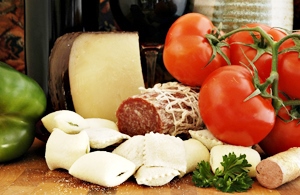
Seasonings and condiments – we all have them in our kitchen to add flavor, interest and complexity to our dishes. Without them, food would be bland at best.
Envision all the spices and dried herbs tucked away in your cabinet, ready to add a pinch of character to your food.
Consider all the various vinegars in your cupboard and citrus in the refrigerator, which add acidity and brightness to food. Aside from table sugar, you possibly also have honey, molasses, maple syrup, and brown sugar, which all increase sweetness in a particular recipe. And when it comes to salt, what used to be basic granulated salt today includes kosher salt, sea salt, and often assorted specialty salts.
What’s in Your Pantry?
Clearly, our palates have become increasingly sophisticated with the range of seasoning possibilities at our fingertips. We have an arsenal of herbs and spices. We have three of our five basic tastes pretty much covered: sweet, sour and salty. Bitter is a bit of an outlier as it is not something that most people purposely add to their food. The remaining basic taste — umami — is glaringly absent… or is it?
Umami Ingredients You May Already Have
 While many people are still learning to recognize the umami in the foods they routinely enjoy, the fact is that our kitchens often have sources of umami in kitchen cabinets and the refrigerator. Ingredients rich in umami include soy sauce, miso, fish sauce, aged cheeses (especially Parmesan), cured sausages, dried hams, sun-dried tomatoes, Worcestershire sauce, dried mushrooms (especially shiitake), and dried beef (i.e., jerkies). Ingredients high in umami tend to be those that contain protein and undergo processes like fermentation, aging, and drying. This frees up glutamate, an amino acid, from the protein strands and is the thing that makes our taste receptors say, “Yum!”
While many people are still learning to recognize the umami in the foods they routinely enjoy, the fact is that our kitchens often have sources of umami in kitchen cabinets and the refrigerator. Ingredients rich in umami include soy sauce, miso, fish sauce, aged cheeses (especially Parmesan), cured sausages, dried hams, sun-dried tomatoes, Worcestershire sauce, dried mushrooms (especially shiitake), and dried beef (i.e., jerkies). Ingredients high in umami tend to be those that contain protein and undergo processes like fermentation, aging, and drying. This frees up glutamate, an amino acid, from the protein strands and is the thing that makes our taste receptors say, “Yum!”
To learn more about the umami-rich ingredients listed above and as well as other umami sources, visit the Umami Information Center, which is a great resource to learn more about umami.
MSG = Pure Umami
All umami-rich ingredients not only contribute a boost in umami, but also bring other flavor profiles that may or may not contribute to the overall success of a particular dish. When you want to just perk up the level of umami without adding other flavors, MSG is the go-to as it is pure umami. In yesteryears before MSG was unjustly and unscientifically maligned, kitchens across the country had their container of MSG (sold under various brand names) right along with their other seasonings. Using a sprinkle of MSG in your food to up umami is analogous to a sprinkle of salt or sugar to raise the level of salinity or sweetness without adding other flavors.
Umami Pantry Idea Starters
Once your umami pantry is built, you can start to purposely incorporate umami into your favorite foods. In another words — play and have fun. Along the way, you will learn where umami-rich ingredients in your pantry work great and where pure umami (MSG) is the perfect addition. To get you started, here are some ideas:
- Sprinkle MSG into egg dishes, soups, stews, and salad dressings.
- Put soy sauce or dark miso into beef stew.
- Add minced sun-dried tomatoes or beef jerky into deviled eggs.
- Season fish, steak or chicken with a mix of salt and MSG before sautéing, roasting, or grilling.
- Add finely minced, reconstituted shiitake mushrooms, grated Parmesan cheese, or dry-cured minced pepperoni to ground beef for hamburgers.
- Sprinkle MSG into grain dishes and see how the dishes are transformed.
Today we know what umami is and how it contributes immeasurably to delicious food. Armed with a well-stocked umami pantry, you are ready to harness the power of umami to make truly craveable food.
- Where Umami is Found (video)
- How to Build Depth and Dimension in a Dish
- More Cooking Tips and Tricks from Chef Koetke
More tips on building an Umami Pantry, from SeriousEats.com: “Here are 15 of the umami-packed ingredients we always have on hand, to give our dishes a boost.”


